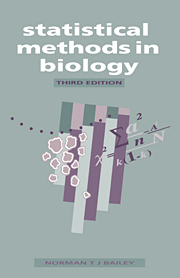Book contents
- Frontmatter
- Contents
- Preface
- 1 Introduction
- 2 Variability and frequency distributions
- 3 Estimation, standard errors and confidence limits
- 4 The basic idea of a significance test
- 5 Simple significance tests based on the normal distribution
- 6 The use of t-tests for small samples
- 7 Contingency tables and χ2
- 8 χ2-tests of goodness-of-fit and homogeneity
- 9 The correlation of measurements
- 10 Regression analysis
- 11 Simple experimental design and the analysis of variance
- 12 Introduction to factorial experiments
- 13 Random samples and random numbers
- 14 Partial correlation and multiple regression
- 15 Non-parametric and distribution-free tests
- 16 Notes on numerical calculation, calculators and computers
- Suggestions for more advanced reading
- Summary of statistical formulae
- Appendix tables
- Index
3 - Estimation, standard errors and confidence limits
Published online by Cambridge University Press: 05 June 2012
- Frontmatter
- Contents
- Preface
- 1 Introduction
- 2 Variability and frequency distributions
- 3 Estimation, standard errors and confidence limits
- 4 The basic idea of a significance test
- 5 Simple significance tests based on the normal distribution
- 6 The use of t-tests for small samples
- 7 Contingency tables and χ2
- 8 χ2-tests of goodness-of-fit and homogeneity
- 9 The correlation of measurements
- 10 Regression analysis
- 11 Simple experimental design and the analysis of variance
- 12 Introduction to factorial experiments
- 13 Random samples and random numbers
- 14 Partial correlation and multiple regression
- 15 Non-parametric and distribution-free tests
- 16 Notes on numerical calculation, calculators and computers
- Suggestions for more advanced reading
- Summary of statistical formulae
- Appendix tables
- Index
Summary
SAMPLING VARIATION
We have in Chapter 2 made the acquaintance of three important types of statistical frequency distribution – the normal, the binomial and the Poisson. As explained, any set of data will usually be, at best, only a sample of some theoretical population. Thus, in Fig. 1 we have the histogram formed by the heights of a sample of 117 males. The smooth curve in the diagram is the best-fitting normal curve, which may be regarded as describing an ideal underlying distribution of stature. The ideal curve is unknown, in this example at any rate, but with a reasonable number of observations we may expect to obtain quite a good approximation to it. This means we must be content to use the sample estimates x and s in place of the unknowns μ and σ. With the binomial distribution we have to estimate the unknown probability of ‘success’ p by the proportion observed in a sample of size n. Similarly the unknown Poisson m must be estimated by the sample mean x.
Now it will easily be realised that even if the underlying distribution remains the same, the estimates of parameters provided by repeated independent samples will vary. It just happens that the particular set of observations available to us gives a certain value of x another set of observations might yield quite a different value of x, the difference being due entirely to chance variation. Fortunately, such discrepancies usually become smaller as more observations are available, and we then say that the estimates are more reliable or precise.
Information
- Type
- Chapter
- Information
- Statistical Methods in Biology , pp. 24 - 30Publisher: Cambridge University PressPrint publication year: 1995
